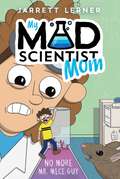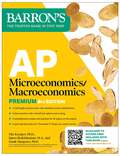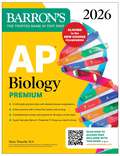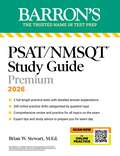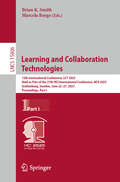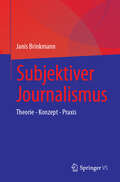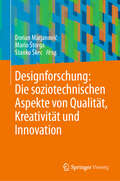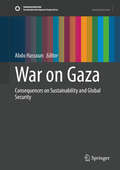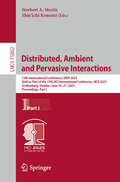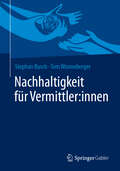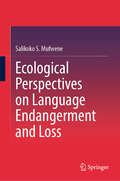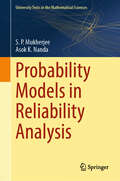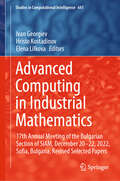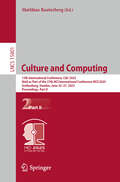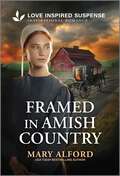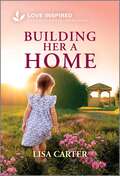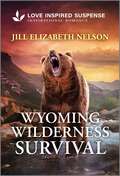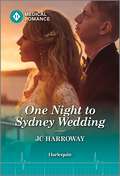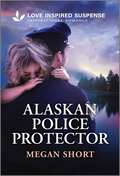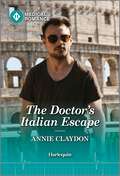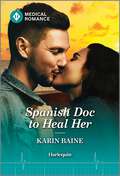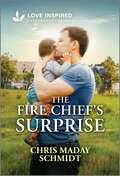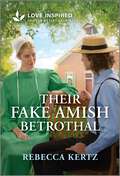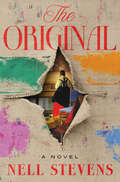- Table View
- List View
No More Mr. Mice Guy (My Mad Scientist Mom)
by Jarrett LernerAri helps a neighbor who accidentally gets shrunk by Ari&’s mom&’s latest invention in this second book in the My Mad Scientist Mom chapter book series from acclaimed author-illustrator Jarrett Lerner.Ari&’s life is filled with school, video games, and his pet turtle, Fred: pretty run-of-the mill stuff. But not anywhere near run-of-the-mill is Ari&’s mom, who&’s a mad scientist. That&’s right, a MAD scientist. Sure, she strives to make people&’s lives better with her inventions, especially at home. But all of Mom&’s inventions seem to go just the slightest bit off kilter. His mom puts a new invention to the test to help clean up the clutter in their house: a magnimizer, which can shrink or enlarge anything! Pretty amazing, right? Well, not if you happen to be Mr. Jakes, their neighbor who comes face to face with this gizmo and becomes the size of a cockroach—and a potential tasty morsel for the resident basement mouse! Can Ari save the day and teeny-weeny Mr. Jakes?
AP Microeconomics/Macroeconomics Premium, Eighth Edition: Prep Book with 4 Practice Tests + Comprehensive Review + Online Practice (Barron's AP Prep)
by Frank Musgrave Ph.D. Elia Kacapyr Ph.D. James Redelsheimer M.A. Barron's Educational SeriesBe prepared for exam day with Barron&’s. Trusted content from AP experts! Barron&’s AP Microeconomics/Macroeconomics Premium, Eighth Edition includes in‑depth content review and practice. It&’s the only book you&’ll need to be prepared for exam day. Written by Experienced Educators Learn from Barron&’s‑‑all content is written and reviewed by AP experts Build your understanding with comprehensive review tailored to the most recent exams Get a leg up with tips, strategies, and study advice for exam day‑‑it&’s like having a trusted tutor by your side Be Confident on Exam Day Sharpen your test‑taking skills with 4 full‑length practice tests–1 AP Micro exam and 1 AP Macro exam in the book, and 1 additional AP Micro exam and 1 additional AP Macro exam online–plus detailed answer explanations for all questions Strengthen your knowledge with in‑depth review covering all units on the AP Microeconomics exam and the AP Macroeconomics exam Determine your strengths and areas for improvement by taking pretests (that cover frequently tested topics) for both subjects Reinforce your learning with multiple-choice and free-response review questions at the end of each chapter, all accompanied by clear answers and explanations and graphs where needed to better illustrate key concepts Robust Online Practice Continue your practice with 1 full-length AP Micro practice test and 1 full-length AP Macro practice test on Barron&’s Online Learning Hub Simulate the exam experience with a timed test option Deepen your understanding with detailed answer explanations and expert advice Gain confidence with scoring to check your learning progress Strengthen your vocabulary with additional terms and their definitions by chapter for both Microeconomics and Macroeconomics. Publisher's Note: Products purchased from 3rd party sellers are not guaranteed by the publisher for quality, authenticity, or access to any online entities included with the product.
AP Biology Premium, 2026: Prep Book with 6 Practice Tests + Comprehensive Review + Online Practice (Barron's AP Prep)
by Mary Wuerth Barron's Educational SeriesBe prepared for exam day with Barron&’s. Trusted content from AP experts!Barron&’s AP Biology Premium, 2026 includes in‑depth content review and practice ALIGNED TO THE NEW COURSE FRAMEWORK. It&’s the only book you&’ll need to be prepared for exam day. Written by Experienced Educators Learn from Barron&’s‑‑all content is written and reviewed by AP experts Build your understanding with comprehensive review tailored to the most recent exam Get a leg up with tips, strategies, and study advice for exam day‑‑it&’s like having a trusted tutor by your side Be Confident on Exam Day Sharpen your test‑taking skills with 6 full‑length practice tests‑‑2 in the book and 4 more online–plus detailed answer explanations for all questions Strengthen your knowledge with in‑depth review covering all units on the AP Biology exam Reinforce your learning with multiple‑choice and short and long free‑response practice questions in each chapter that mirror the format of actual exam questions and are accompanied by clear answers and explanations Expand your understanding with a review of the major statistical tests and lab experiments that will enhance your scientific thinking skills Robust Online Practice Continue your practice with 4 full‑length practice tests on Barron&’s Online Learning Hub Simulate the exam experience with a timed test option Deepen your understanding with detailed answer explanations and expert advice Gain confidence with scoring to check your learning progress Power up your study sessions with Barron's AP Biology on Kahoot!‑‑additional, free practice to help you ace your exam! Publisher's Note: Products purchased from 3rd party sellers are not guaranteed by the publisher for quality, authenticity, or access to any online entities included with the product.
PSAT/NMSQT Premium Study Guide, 2026: 2 Practice Tests + Comprehensive Review+ 200 Online Drills (Barron's Test Prep)
by Brian W. Stewart M.Ed. Barron's Educational SeriesBarron&’s PSAT/NMSQT Study Guide Premium, 2026 includes everything you need to be prepared for exam day with comprehensive review and practice that reflects the digital PSAT/NMSQT! Internationally known expert author and tutor, Brian W. Stewart, a Princeton graduate and perfect SAT score holder, puts his 30,000 plus hours of teaching and tutoring experience to work for you. He gives you the same clear and concise advice to excel on the PSAT and SAT that has helped his students from all ability levels earn perfect scores and admission to Ivy League universities.All the Review You Need from an SAT Expert An expert overview of the digital PSAT/NMSQT, including answers to frequently asked questions, advice on curbing test anxiety, techniques for the digital interface, and information about the National Merit Scholarship program In-depth subject review and practice questions covering the each section of the test for Reading and Writing and Math The latest strategies for success for all question types on the digital PSAT, such as Command of Evidence, Words in Context, Rhetorical Synthesis, Transitions, Algebra, and Geometry and Trigonometry Tips throughout from the author--an experienced SAT tutor and test prep professional Practice with Confidence 2 full-length digital PSAT practice tests in the book- 1 diagnostic test to assess your skills and target your studying plus 1 fully adaptive Additional practice questions on each subject throughout the review chapters Advanced skill-building practice drills for students seeking National Merit Scholarship recognition Detailed answer explanations for all practice questions Online Practice 200 Online practice drills Detailed answer explanations Scoring to check your learning progress An online vocabulary appendix for extra review Publisher's Note: Products purchased from 3rd party sellers are not guaranteed by the publisher for quality, authenticity, or access to any online entities included with the product.
Learning and Collaboration Technologies: 12th International Conference, LCT 2025, Held as Part of the 27th HCI International Conference, HCII 2025, Gothenburg, Sweden, June 22–27, 2025, Proceedings, Part I (Lecture Notes in Computer Science #15806)
by Brian K. Smith Marcela BorgeThe three-volume set LNCS 15806–15808 constitutes the thoroughly refereed proceedings of the 12th International Conference on Learning and Collaboration Technologies, LCT 2025, held as part of the 27th International Conference, HCI International 2025, which took place in Gothenburg, Sweden, June 22-17, 2025. The total of 1430 papers and 355 posters included in the HCII 2025 proceedings was carefully reviewed and selected from 7972 submissions. The papers have been organized in topical sections as follows: Part I: Designing Learning Experiences; Technological Innovation in EducationPart II: From Human Teachers to AI Educators; Intelligent Learning Environments Part III: Serious Games and Gamification; Immersive Learning; Understanding Learning Experiences
Subjektiver Journalismus: Theorie - Konzept - Praxis
by Janis BrinkmannJournalismus wandelt sich – und bringt zunehmend neue Formen und Formate hervor, die u.a. investigative, narrative, interpretative oder partizipative Muster, Mechanismen und Merkmale des Journalismus integrieren und neu arrangieren. Doch wie sich ein teils explizit subjektiver und meinungsbasierter „Neuer Journalismus“ entwickelt und in der Praxis an Einfluss gewinnt, ist angesichts der oft fluiden Forschungsgegenstände in der Journalistik bislang nicht erforscht. Die vorliegende Studie, die am Institut für Journalistik an der Fakultät Kulturwissenschaften der Technischen Universität Dortmund als Habilitationsschrift eingereicht wurde, widmet sich daher Programmen, Praktiken und Leistungspotenzialen eines subjektiven Journalismus, wie er sich gegenwärtig in Formen des Social Journalism vollzieht (z.B. bei funk, Vice, BuzzFeed), der über soziale Medien jüngere Zielgruppen adressiert und sich radikal an deren Thematisierungs-, Präsentations-, Nutzungs- und Rezeptionserwartungen orientiert.Vor einer konstruktivistisch geprägten Hintergrundfolie wird zunächst ein integrativ-intergrativer Theorierahmen aufgespannt, der strukturell-individualistische mit figurations-analytischen und praxistheoretischen Bausteinen verknüpft, um die Konstruktionsprogramme, Praxiskonstellationen und Leistungspotenziale von Formen des subjektiven Journalismus zu rekonstruieren, zu analysieren und zu bewerten. Dafür wird ein triangulatives Methodendesign gewählt: Anhand kontemporärer Angebote eines subjektiven Journalismus, der sich besonders augenfällig in den Presenter-Reportagen des öffentlich-rechtlichen Content-Netzwerks funk manifestiert, werden Programme, Praktiken und Potenziale des subjektiven Journalismus durch quantitative und qualitative Inhaltsanalysen sowie eine flankierende Expert:innen-Befragung beteiligter Journalist:innen untersucht, um daraus Muster, Mechanismen und Merkmale eines „Neuen Journalismus“ zu destillieren. Als zentrales Ergebnis der Studie gewinnt eine nach den Mechanismen sozialer Medien für junge Zielgruppen aktualisierte und modifizierte Form des radikal subjektiven New Journalism an Kontur: Journalistische Wirklichkeit konstruieren Reporter:innen über eine an Zielgruppen- und Lebenswelt-Themen junger Publika orientierte Thematisierung, hybride Web-Reportagen, die konsequent eigene Meinung bzw. Haltung sowie subjektive Perspektiven integrieren sowie eine starke Fokussierung auf sich selbst und auf Protagonist:innen als Quellen und Akteure. Die Unterschiede zwischen verschiedenen empirisch rekonstruierbaren subjektiven Journalismen wie die eher reporter- bzw. recherche-getriebenen Slow Journalism und Gonzo-Journalismus oder die stärker protagonisten- bzw. emotions-getriebenen empathischer Journalismus und Selfie-Journalismus lassen sich am Beispiel der ausgewählten funk-Formate Y-Kollektiv, STRG_F, reporter, follow me.reports und Die Frage prägnant herausarbeiten. Für subjektiv modifizierte Praktiken wie thesengeleitete Recherche, interpretatives Storytelling, On-Presenting oder ein reflexives Framing greifen die Reporter:innen auf Modalitäten von Signifikationsregeln und autoritative Ressourcen wie persönliche Erfahrungen und Erlebnisse, eigene Meinungen und Haltungen sowie subjektive Darstellungs- und Erzählmuster zurück, die zu einem nunmehr artifiziell inszenierten und nicht länger authentisch konstruierten „strategischen Ritual“ der Subjektivität degenerieren, wenn Praxiskonstellationen wie die storybasierte Enthüllung, teilnehmende Beobachtung, emotionale Befragung oder selbstzentrierte Begleitung repetitiv Subjektivität in alle journalistischen Praktiken weben.
Designforschung: Die soziotechnischen Aspekte von Qualität, Kreativität und Innovation
by Mario Štorga Dorian Marjanović Stanko ŠkecDas Buch bietet einen ganzheitlichen Einblick in die Designforschung, eine umfassende und zusammenhängende Vision des neuesten Wissens über die Schaffung und Verbesserung hochwertiger Produkte, Kreativität und Innovation. Die Beiträge in diesem Band dienen als erhellender Kompass für das Verständnis der Ingenieurdesignforschung und bieten eine umfassende Perspektive auf Produktentwicklung, Kreativität, Innovation, Erfindung und Produktivität, indem sie die historische Entwicklung der Designwissenschaft aufzeigen und die Grenzen der Ingenieurdesignforschung erkunden. Die vorgestellten Bildungsprojekte wurden an EU-Universitäten durchgeführt und bieten Einblicke für zukünftige Designkurse. Zentral in den Diskussionen ist die entscheidende Rolle der soziotechnischen Dimensionen im Ingenieurdesign, wobei Fragen der Kreativität, Qualität, menschzentrierter Methoden und der Anforderungen neuer Technologien erörtert werden, die ihre entscheidende Rolle für den Erfolg des Ingenieurdesigns betonen. Der Text bietet einen panoramischen Überblick über den aktuellen Stand der Designforschung und kritische Themen und liefert eine umfassende Übersicht für junge Forscher. Pädagogen und Mentoren werden ihr Wissen vertiefen, während Experten ihre Methoden und Werkzeuge verfeinern.
War on Gaza: Consequences on Sustainability and Global Security (Sustainable Development Goals Series)
by Abdo HassounThe relentless bombardment and blockade on Gaza have not only drastically restricted the inflow of essential food supplies but have also led to a catastrophic humanitarian crisis with unprecedented casualties. The widespread destruction has crippled the ability of the population to grow and process food, leaving Gazans without sufficient access to basic nutrition and pushing them to the brink of famine. Building on the previous work of Dr. Hassoun on acute food insecurity and malnutrition in Gaza, this book addresses not only Sustainable Development Goal (SDG) 2—Zero Hunger, SDG 3—Good Health and Well-being, and SDG 6—Clean Water and Sanitation, but all seventeen SDGs. While brief reports have been published on the topic, this will be the first in-depth scholarly work, offering case studies, data-driven analysis from various fields, and a comprehensive examination of the multidimensional and devastating impacts of war. With an urgent and multidisciplinary perspective, this book highlights the interconnectedness of war, sustainability, and global security, emphasizing how hostilities in Gaza have reversed progress toward achieving all SDGs, both in Gaza and beyond. Bringing together diverse expertise from 60 authors across 27 countries, the book showcases the international and interdisciplinary collaboration underlying its research. Through a series of carefully curated chapters written by specialists in various fields, it provides a comprehensive analysis of how war has affected societal structure, economic resilience, and environmental sustainability in Gaza. For each issue addressed, the text offers strategic insights and practical measures aimed at mitigating damage and fostering resilience. This book serves as a critical resource for policymakers, researchers, humanitarian organizations, and anyone who is interested in understanding and addressing the complex dynamics of conflict and sustainability.
Distributed, Ambient and Pervasive Interactions: 13th International Conference, DAPI 2025, Held as Part of the 27th HCI International Conference, HCII 2025, Gothenburg, Sweden, June 22–27, 2025, Proceedings, Part I (Lecture Notes in Computer Science #15802)
by Shin’ichi Konomi Norbert A. StreitzThis two-volume set LNCS 15802-15803 constitutes the refereed proceedings of the 13th International Conference on Distributed, Ambient and Pervasive Interactions, DAPI 2025, held as part of the 27th International Conference on Human-Computer Interaction, HCII 2025, in Gothenburg, Sweden, during June 22-27, 2025. The total of 1430 papers and 355 posters included in the HCII 2025 proceedings was carefully reviewed and selected from 7972 submissions.The two volumes cover the following topics:Part I: Designing and developing intelligent environments; and user experience in intelligent environments.Part II: Smart cities and public spaces; eXtended reality and robots in intelligent environments; and wellbeing in intelligent environments.
Nachhaltigkeit für Vermittler:innen
by Stephan Busch Tom WonnebergerDieses Buch zeigt, was Nachhaltigkeit bei Finanzen und Versicherungen bedeutet: Informieren und sensibilisieren wir unsere Kund:innen. Finden wir neue Themen der Ansprache. Machen wir Druck auf unsere Produktpartner, ihre Angebote umzustellen. Nehmen wir das Heft des Handelns in die Hand und gestalten unsere kleinen wir großen Unternehmen um und machen sie zukunftsfest. Werden wir unserer sozialpolitischen Verantwortung gerecht. Tragen wir unseren Teil dazu bei, die Welt ein kleines Stück besser zu machen. Das Buch besteht aus drei Teilen. Im ersten beschäftigen wir uns mit den theoretischen Grundlagen. Wir erläutern, was Nachhaltigkeit ist und was es bedeutet. Wir begründen, warum es in jedem Fall wichtig und richtig ist, sich damit zu beschäftigen. Im zweiten Teil widmen wir uns den Strategien. Wir zeigen, wie die Transformation gelingt. Ein besonderes Augenmerk legen wir auf den Aspekt der nachhaltigen Beratung. Im dritten Teil geht es um die praktische Umsetzung. Hier zeigen wir konkrete Ansätze und Instrumente eingebettet in einen logischen Fahrplan, den Sie Stück für Stück abarbeiten können. Ganz am Ende finden Sie eine Checkliste und Arbeitsblätter.
Ecological Perspectives on Language Endangerment and Loss
by Salikoko S. MufweneThis book discusses various issues arising from the dominant discourse on language endangerment and loss in linguistics. Are the terms mother tongue, heritage language, and ancestral language interchangeable? Does a child receiving formal education in a mother tongue different from that or those of his/her parents lose a culture that he/she &“should&” otherwise inherit? Is a language separate from the culture in which its speakers evolve and it is being practiced? Thus, is a population shifting to a dominant language necessarily abandoning its traditional culture ipso facto or is it also reshaping it along with that associated with the new language into a new, mixed culture? Are cultures intended to be static? Must speakers of particular languages be wedded to them in the same way they are to their genes? What can we learn about language shift, language vitality, and human adaptiveness from the protracted history of mankind? These and a host of other issues regarding the intertwining of colonization, globalization, language, and culture are discussed in this book, inviting linguists and other interested scholars to be critical participants in the current debate.
Probability Models in Reliability Analysis (University Texts in the Mathematical Sciences)
by S. P. Mukherjee Asok K. NandaThis book delves into the fundamental theoretical aspects of reliability analysis, focusing on various probabilistic models. These models are essential for representing random variations in underlying variables such as time-to-failure, the number of failures between consecutive repairs and similar metrics. The calculation, estimation and prediction of reliability all hinge on using appropriate probability models. The book introduces various models beneficial for researchers in the field of reliability. It also provides a comprehensive overview of the available models, highlighting their distinctive features and practical applications in a narrative format. The content of the book is designed to appeal to a broad readership. Students and researchers in the field of reliability analysis will find a comprehensive yet easily understandable summary of models applicable to their data sets of interest. It should be noted, however, As stated clearly in the preface, this book does not illustrate applications of the models discussed in terms of real-life data.
Advanced Computing in Industrial Mathematics: 17th Annual Meeting of the Bulgarian Section of SIAM, December 20–22, 2022, Sofia, Bulgaria, Revised Selected Papers (Studies in Computational Intelligence #641)
by Ivan Georgiev Hristo Kostadinov Elena LilkovaThis book gathers the peer-reviewed proceedings of the 17th Annual Meeting of the Bulgarian Section of the Society for Industrial and Applied Mathematics, BGSIAM'22, held in Sofia, Bulgaria. The general theme of BGSIAM'22 was industrial and applied mathematics with particular focus on: mathematical physics, numerical analysis, high performance computing, optimization and control, mathematical biology, stochastic modeling, machine learning, digitization and imaging, advanced computing in environmental, biomedical and engineering applications.
Culture and Computing: 13th International Conference, C&C 2025, Held as Part of the 27th HCI International Conference, HCII 2025, Gothenburg, Sweden, June 22–27, 2025, Proceedings, Part II (Lecture Notes in Computer Science #15801)
by Matthias RauterbergThis book constitutes the refereed proceedings of the 13th International Conference on Culture and Computing, held as part of the 27th International Conference, HCI International 2025, which took place in Gothenburg, Sweden, during June 22–27, 2025. The total of 1430 papers and 355 posters included in the HCII 2025 proceedings was carefully reviewed and selected from 7972 submissions. Two volumes of the HCII 2025 proceedings are dedicated to this year&’s edition of the C&C conference: Part I focuses on topics related to Interactive Cultural Experiences and Traditional Craft Preservation, AI-empowered Art and Computational Creativity, and Virtual, Augmented, and Mixed Reality for Cultural Heritage. Part II focuses on topics related to Interactive Media, Embodied Cognition, and Digital Communication in Cultural Experiences; Health and Well-Being; and Bie-Modernism and Cultural Computing.
Framed in Amish Country
by Mary AlfordTo prove her innocence she&’ll have to expose a lethal conspiracy. A frantic call from her best friend sends district attorney Paige Grayson running right into a trap—and now she&’s being framed for her friend&’s murder. With the police after her and evidence against her stacking up, she seeks refuge in Amish country—and the help of her first love, Elijah King, to clear her name. To expose the drug dealer setting Paige up, they must work together while evading a ruthless criminal and the police. With threats closing in and time running out, one wrong move could be their last.From Love Inspired Suspense: Courage. Danger. Faith.
Building Her a Home: An Uplifting Inspirational Romance
by Lisa CarterCan one little girl&’s wish Bring two lonely hearts together? When country music singer Noah Brenden walked away from fame to raise his orphaned niece, he made a vow never to stay anywhere long enough to be recognized. So when a blast from his past, music teacher Chloe Randolph, falls into his arms while trying to rescue little Lili&’s cat, it&’s his cue to leave. But Lili longs for a permanent home, and Chloe desperately needs Noah&’s help to restore the town&’s historic theater, promising to keep his true identity safe in return. Staying put wasn&’t his plan, but could it lead to the future he never knew he was looking for?From Love Inspired: Uplifting stories of faith, forgiveness and hope.
Wyoming Wilderness Survival
by Jill Elizabeth NelsonSeeking refuge in the mountains… with killers in pursuit. Just as EMT Tracey Graham&’s murder conviction is about to be overturned, she is ambushed by the crime family who framed her—and now want her dead. Fleeing into the woods sends her into the path of ex-cop Callum Mitchell, who has his own history with her assailants. But when his secluded cabin comes under attack, the wilderness is their only escape route. With Callum&’s toddler son in tow, they must evade hitmen while navigating treacherous terrain. But can they make it out alive…when there are predators around every corner? From Love Inspired Suspense: Courage. Danger. Faith.
One Night to Sydney Wedding (Jet Set Docs)
by JC HarrowayFrom one night to discovering they&’re colleagues, a pregnancy and then a marriage on the horizon—is this really what the doctor ordered to heal a heartbreak? Find out in this Jet Set Docs story by JC Harroway! FROM NO STRINGS TO CONVENIENT RINGS! Arriving in Sydney, English doctor Gigi Lane has left her broken engagement, her best friend&’s betrayal and a heap of hurt behind her. A hot fling with a stranger is exactly what she needs! Only when she takes up her temporary stint as an ED doc does she discover she&’ll be working with her heartthrob hookup, surgeon Dante Scott—and she&’s pregnant with his baby! With just two months until her visa expires, Dante tells her there&’s only one acceptable solution…and it starts at the altar!From Harlequin Medical: Life and love in the world of modern medicine. Jet Set Docs
Alaskan Police Protector
by Megan ShortTo save a child, he has to risk his own life. When a minivan slides off the road into an icy lake, Officer Samuel Miller narrowly rescues a woman and child from certain death. Only, Rachel Harding insists the crash is no accident—it&’s eerily similar to how her sister and brother-in-law recently died. As the unexplained attacks escalate, Samuel is determined to protect Rachel and her orphaned niece at all costs. But when they make a shocking discovery, their investigation becomes even more dangerous, and survival may be impossible.From Love Inspired Suspense: Courage. Danger. Faith.
The Doctor's Italian Escape (Jet Set Docs)
by Annie ClaydonIn this Jet Set Docs story by Annie Claydon, a trauma doc runs from a troubled past to Rome for a fresh start, with absolutely no time for romance…until the arrival of a beautiful new doctor! HIS BREATH OF FRESH AIR Four years ago, Dr. Joe outran the grief of losing his adoptive parents, his only rock in a troubled childhood, by escaping to stunning Rome. Between shifts as a trauma doc and running a free clinic for patients facing life-changing conditions, he has no time for romance—just how he likes it! Because love requires trust—not something Joe does easily! Until beautiful, wealthy Dr. Isabella volunteers at his clinic and challenges his preconceptions by saving the place. And suddenly Joe finds a connection he&’s never felt before…From Harlequin Medical: Life and love in the world of modern medicine. Jet Set Docs
Spanish Doc to Heal Her (Jet Set Docs)
by Karin BaineIn this Jet Set Docs story by Karin Baine, Dr. Inés returns to Spain, where she meets her infuriatingly handsome new colleague, Dr. Ángelo. As their undeniable chemistry burns hotter every day, can they both heal from their pasts for a second chance at love? LOVE HAPPENS WHEN YOU LEAST EXPECT IT! It&’s often said that home is where the heart is. But Dr. Inés had zero intention of returning to Spain and her controlling family… Until her ex-boyfriend left her with no choice but to work at her father&’s medical practice. The only ray of hope? Inés&’s new coworker, Dr. Ángelo, who is as infuriating as he is irresistible. Yet while their attraction burns hotter than the Mediterranean sun, is Inés ready to bring down her barriers and let Ángelo in?From Harlequin Medical: Life and love in the world of modern medicine. Jet Set Docs
ER Doc's South Pole Reunion (Jet Set Docs)
by Juliette HylandA medical posting in the South Pole brings two college sweethearts together again…but can their old flame be rekindled after a past of heartbreak? Find out in this Jet Set Docs story by Juliette Hyland! A DOC TO MELT HIS HEART! Recovering romantic Dr. Sam Miller has already experienced a lifetime&’s worth of heartbreak. So he&’s replaced ill-fated crushes with adrenaline rushes! Until landing his dream job at the South Pole brings him face-to-face with Dr. Forrest Wilson, his college boyfriend. Their breakup left them both shattered… Still, Sam can&’t bring himself to ice him out. But when Forrest is determined to reclaim his place in Sam&’s life, can he let himself be tempted—and believe that his ex will fight for their forever?From Harlequin Medical: Life and love in the world of modern medicine. Jet Set Docs
The Fire Chief's Surprise: An Uplifting Inspirational Romance
by Chris Maday SchmidtHe wasn&’t looking for love… Until one little boy came into his life. Fire chief Josh Rogers has just three months to get married or risk losing custody of his late foster brother&’s infant son. So when Annie Greene offers to help him find a wife in exchange for repairs at her bakery, it seems like the perfect solution. As the three spend time together, Josh can&’t help but feel that Annie&’s the only person he can picture filling the role of Finn&’s mother. But can they set aside their past insecurities and embrace a chance at happily-ever-after?From Love Inspired: Uplifting stories of faith, forgiveness and hope.
Their Fake Amish Betrothal: An Uplifting Inspirational Romance
by Rebecca KertzCan their temporary arrangement… Become a permanent love? Desperate for a fresh start, Abigail Yost moves to a new Amish community to become a teacher—and to escape the heartache of her sister&’s engagement to Abby&’s former beau. Only, one of the townsfolk isn&’t so welcoming. Carpenter Nathaniel Hostetler attempts to avoid the newcomer while building her cottage—he&’d much prefer to be working on setting up a new dairy farm. When he witnesses Abby&’s distress over a wedding invitation, Nate makes an unexpected offer: a fake engagement. But as the ceremony date approaches, they find that their pretend feelings are starting to become all too real…From Love Inspired: Uplifting stories of faith, forgiveness and hope.
The Original: A Novel
by Nell StevensIn a grand English country house in 1899, an aspiring art forger must unravel whether the man claiming to be her long-lost cousin is an impostor. Brought to her uncle’s decaying Oxfordshire estate when she was a child, Grace has grown up on the periphery of a once-great household, an outsider in her own home. Now a self-possessed and secretive young woman, she has developed unusual predilections: for painting, particularly forgery; for deception; for other girls. As Grace cultivates her talent as a copyist, she realizes that her uncanny ability to recreate paintings might offer her a means of escape. Secretly, she puts this skill to use as an art forger, creating fake masterpieces in candlelit corners of the estate. Saving the money she makes from her sales, she plans a new life far from the family that has never seemed to want her. Then, a letter arrives from the South Atlantic. The writer claims to be her cousin Charles, long presumed dead at sea, who wishes to reconnect with his family. When Charles returns, Grace’s aunt welcomes him with open arms; yet fractures appear in the household. Some believe he is who he says he is. Others are convinced he’s an impostor. As a court date looms to determine his legitimacy—and his claim to the family fortune—Grace must decide what she believes, and what she’s willing to risk. Is Charles really her cousin? An interloper? A mirror of her own ambitions? And in a house built on illusions, what does authenticity truly mean—in art, in love, and in family? Deftly plotted and shimmering with Nell Stevens’s distinctive intelligence, style, and wit, The Original takes readers on an unforgettable adventure through a world of forgeries, family ties, and the fluctuations in fortune that can change our fate.
